
Dichopogon strictus, commonly known as chocolate lily, is a herbaceous perennial plant species native to Australia.

Arthropodium milleflorum, the pale vanilla lily, is a species of herbaceous perennial plants native to Australia. It occurs in various habitats including alpine areas and grows to between 0.3 and 1.3 metres high and 0.3 metres wide. The fleshy tubers were eaten by Aboriginal Australians. The plant has a strong vanilla fragrance, especially noticeable on warm days.

Banksia gardneri, commonly known as prostrate banksia, is a species of prostrate shrub that is endemic to Western Australia. It has pinnatipartite or serrated leaves, usually rusty brown flowers, and up to twenty-five elliptical follicles in each fruiting head. It occurs along the west part of the south coast of the state.
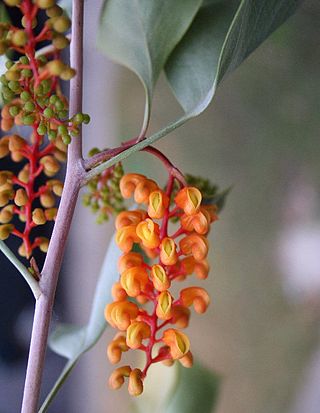
Grevillea wickhamii, commonly known as Wickham's grevillea, holly-leaf grevillea or lgarrmari in Djaru, is species of flowering plant in the family Proteaceae and is endemic to northern Australia. It is an erect shrub or spindly tree with holly-like, broadly egg-shaped leaves with 2 to 7 shallow teeth, and down-curved clusters of flowers, the colour depending on subspecies.
Banksia fuscobractea, commonly known as the dark-bract banksia, is a species of shrub that is endemic to a small area in the south-west of Western Australia. It has prickly, serrated, wedge-shaped leaves, pale yellow and cream-coloured flowers in heads of up to almost two hundred, and three or four egg-shaped follicles in each head.
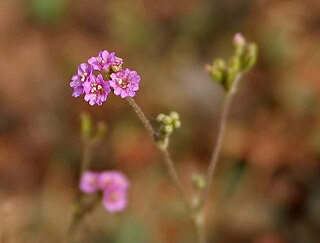
Boerhavia is a genus of over 100 species in the Nyctaginaceae family. The genus was named for Herman Boerhaave, a Dutch botanist, and the genus name is frequently misspelled "Boerhaavia". Common names include spiderlings and hogweeds.
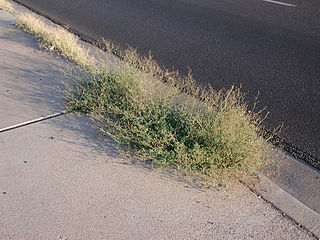
Boerhavia intermedia is a species of spiderling plant known by the common name five-wing spiderling. It is sometimes considered a subspecies of the common weed Boerhavia erecta. This spiderling is a fairly widespread annual herb of the southwestern United States and northern Mexico. It is somewhat variable in appearance, but in general it is loosely clumping, raising erect stems up to half a metre in height. It has lance-shaped, wavy-margined leaves and bears a branching inflorescence of clustered or singular flowers, each pale pink flower only one or two millimetres across. The clustered fruits that appear afterwards are tiny club-shaped, ridged achenes less than 3 mm long. This is a hardy plant, growing in arid, rocky, or disturbed areas, and often showing up as a roadside weed.

Melicytus dentatus, the tree violet, is a shrub that is native to south-east Australia. It grows up to 4 metres high and has branchlets that are often armed with spines and have leaves that are 5 to 50 mm long and sometimes toothed. The flowers appear in spring and summer and are pale yellow, 3 to 5 mm in length, and have petals that are recurved at the tips. These are followed by pale green to purple-black, rounded berries which are 4 to 5 mm in diameter.
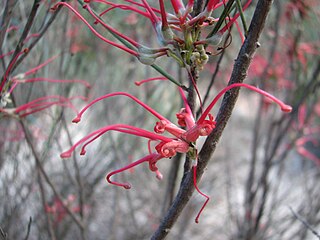
Grevillea sarissa, commonly known as wheel grevillea, is a species of flowering plant in the family Proteaceae and is native to South Australia and Western Australia. It is a spreading shrub, usually with linear leaves, and more or less erect, wheel-like to more or less spherical clusters of red or yellow flowers.
Adenanthos ileticos is a species of shrub in the family Proteaceae. It has roughly triangular, lobed leaves, and pale pink-red and cream, inconspicuous flowers. A rare species, it is known only from a single location in the south-west of Western Australia. It was discovered in 1968, and immediately brought into cultivation, but it would not be formally published and named until a decade later.

Adenanthos meisneri, commonly known as prostrate woollybush, is a species of shrub in the family Proteaceae. It is endemic to the south-west of Western Australia.

Adenanthos pungens, the spiky adenanthos, is a species of shrub in the family Proteaceae. It is endemic to the south-west of Western Australia.

Acacia aspera, commonly known as rough wattle, is a spreading shrub which is endemic to south-eastern Australia. It grows to up to 2 metres high and has phyllodes which are 10 to 30 mm long and 2 –4 mm wide. The pale yellow to gold globular flowerheads appear singly or in groups of two in the axils of the phyllodes in July to September, followed by curved or coiled seed pods which are 20 to 70 mm long and 3 to 5 mm wide.

Leionema phylicifolium, commonly known as alpine phebalium, is a shrub that is endemic to south-eastern Australia. It is a small shrub with green, smooth, leathery leaves and pale yellow flowers in spring.
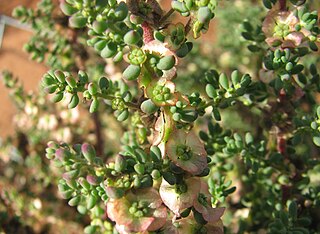
Maireana brevifolia is a shrub that is native to Australia and naturalised in South Africa, the Middle East and the Canary Islands. Common names in Australia include cotton bush, eastern cotton-bush, short-leaf bluebush, small-leaf bluebush and yanga bush. It grows to between 0.2 and 1 metre high. The flower-like fruits are up to 9 mm in diameter and comprise 5 paper-thin wings. It is one of the first species to appear in disturbed saline habitats.
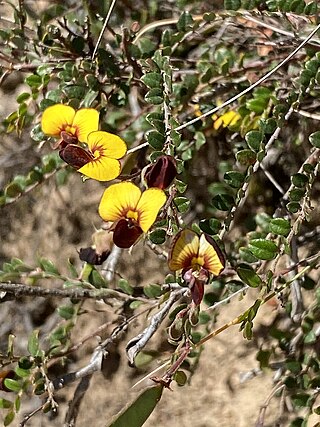
Bossiaea prostrata, commonly known as creeping bossiaea, is a prostrate understory shrub in the pea family, Fabaceae. It is a widespread species with orange-yellow flowers, purple-brown keels and trailing branches.

Grevillea bracteosa, also known as bracted grevillea, is a species of flowering plant in the family Proteaceae and is endemic to the south-west of Western Australia. It is an erect to spreading shrub usually with linear leaves, and oval to more or less spherical clusters of glabrous pale green to greenish-pink flowers with a pink or white style.
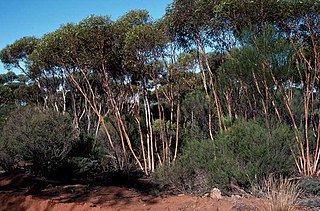
Eucalyptus cerasiformis, commonly known as the cherry-fruited mallee, is a mallee that is endemic to a small area of Western Australia. It has smooth, pale grey, sometimes powdery bark, lance-shaped adult leaves, flower buds in groups of seven, pale yellow or whitish flowers and cylindrical or bell-shaped fruit.

Eucalyptus crucis is a species of mallee that is endemic to Western Australia. There are three subspecies, commonly known as silver mallee or Southern Cross mallee,, narrow-leaved silver mallee, and Paynes Find mallee,. It has rough bark that is shed in curling flakes, more or less round, glaucous juvenile leaves, egg-shaped intermediate leaves and lance-shaped adult leaves. The type of bark and the proportion of juvenile, intermediate and adult leaves in the crown of mature plants varies with subspecies. The flower buds are arranged in groups of seven in leaf axils, the flowers are whitish to pale yellow and the fruit is a conical to hemispherical capsule.

Conostylis androstemma is a tufted perennial plant species in the family Haemodoraceae. It is endemic to the south-west of Western Australia. Plants grow to between 10 and 30 cm high and produce cream to pale yellow flowers between May and August in the species' native range.


















